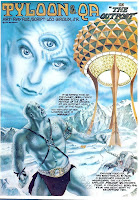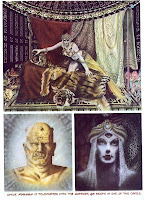
I remember seeing ‘Amazing Adventures’ No. 18, featuring Killraven and the War of the Worlds, on the shelf with the other comics at the 7-11 store in Elmira Heights, New York, in 1973.
After looking through it I thought it was an interesting comic, set in a near-future Earth devastated by a successful second invasion of the Martians from the H. G. Wells novel. The opening issue featured the ruins of New York City, mutants, monsters, high-tech weaponry, and an offbeat hero in Killraven. But I didn’t have enough extra cash to purchase it (even though 20 cents seems like a paltry sum nowadays, back then it was a lot of money in terms of allowance; this was when a Fudgesicle cost only 5 cents, and a gallon of gas less than 50 cents). So I wound up buying a copy of Jack Kirby’s ‘The Demon’, and a copy of ‘Conan’.
Fortunately Marvel has released all the first generation Killraven stories in one of its omnibus b & w ‘Essentials’ formats. At more than 800 pages in length, ‘Killraven Vol. 1’ gives you the Amazing Adventures’ run of ‘War of the Worlds’ from issues 18 to 39. There’s also issue #45 of ‘Marvel Team Up’ featuring Killraven and Spider Man (?!) and two one-shot Killraven issues from the 80s.
The Killraven stories are derived from many pop-culture idioms of the early 70s, with perhaps ‘Beneath the Planet of the Apes’ serving as one of the more central idioms. Each issue has the sort of frantic, if unsophisticated, energy that defined superhero comics in the early to mid 70s.
Amazing Adventures No. 23 is a gem in this regard. The story features a mutated, former Secret Service agent (!) named ‘Rattack (!) who lives in the tunnels beneath the ruins of the White House. Borrowing heavily from the film ‘Willard’, already a sci-fi landmark in the early 70s, the plot sees the bucktoothed Rattack and his furry rodent friends commissioned to eliminate Killraven in gruesome fashion (particularly for a Code-approved comic !). I’ve tried to scan a couple of the more gripping pages without breaking open the spine of my yellowing copy of the book (my Canon 4400F scanner lacks a beveled edge best used for scanning bound books).
I won’t spoil the story by posting the finale of the story, but these pages make for great art by Herb Trimpe, arguably the best of the Jack Kirby-inspired artists on Marvel’s staff at the time.

























































